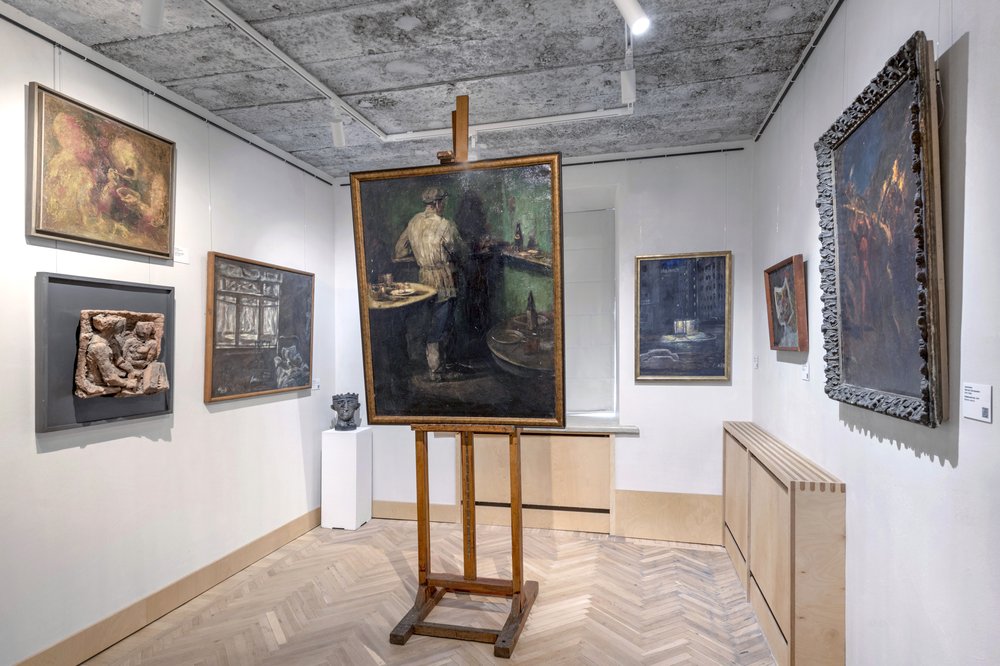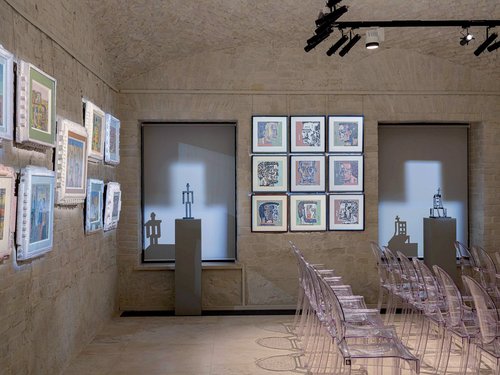The Other Side of the Easel: a new museum in Moscow

Maslovka. The Artists’ Town Museum. Exhibition view. Moscow, 2025. Photo by Alexey Narodnitsky. Courtesy of Maslovka. The Artists’ Town Museum
Maslovka, a Stalin-era artists’ commune that has endured since the 1930s, now houses a new on-site museum. In its intimate spaces, visitors can encounter works by more than one hundred artists across several generations, while experiencing the distinctive creative spirit that still defines this Moscow neighbourhood.
Capturing the elusive genius loci within the walls of a museum is no simple task. Yet in Moscow, a small museum is attempting just that: opening its doors to reveal a glimpse of the hidden world of an artist’s commune that has endured against all the odds since the early Soviet era. Located on the third floor of a residential building with studio spaces, in a few rooms that used to house a nursery, the museum features the work of one hundred and thirty individual artists within a modest 300 square metres. Wall space is scarce; some artworks are placed on window-sills or hung just below the ceiling, so you have to tilt your head to view them. Socialist realists and unofficial artists coexist peacefully on these walls.
This reflects the reality of the ‘artist town’ on Verkhnyaya Maslovka Street, a self-contained urban dwelling built according to an order by Stalin in the 1930s. Here, artists could focus on their work without being distracted by the cares of everyday life. There were buildings with studios for sculptors and painters, as well as flats. Besides the nursery school, there was also a canteen, a laundry, and even a rooftop solarium. This concept originated with the founding members of AKhRR, one of numerous avant-garde artists’ associations in Russian in the 1920s. However, the studios and flats were not only allocated to its members, but also to their creative opponents, such as Vladimir Tatlin (1885–1953) and David Sterenberg (1881–1948). In the 1930s, all artistic associations were dissolved and replaced by Union of Artists. This union became a tool of the government, controlling artists by distributing studios and lucrative commissions. Following the collapse of the USSR, some local branches of the Union survived, outliving the Soviet system that had created them. To this day, in the Russian capital, the Moscow Union of Artists has retained control of studios scattered across the city, including those on Maslovka. It rents them out to member artists at rates far below market price.
Back in the 1930s, German journalists who visited the newly built Maslovka cluster called it an “artist commune”. However life there was far from an idealistic vision. The town saw many quarrels and rivalries, which were typical of Soviet ‘communal flats’. After World War II, the renowned Soviet sculptor Evgeny Vuchetich (1908–1974) stormed into a studio shared by the sculptors Meer Eisenshtadt (1895–1961) and Samuil Makhtin (1902–after 1970), wearing military boots and brandishing a revolver. He evicted his colleagues and took over their space. As nobody dared to confront the creator of the ´Monument to the Soviet Soldier´ in Berlin, the Union of Artists later gave Eisenshtadt and Makhtin two smaller, separate studios. When an artist died, the Artists’ Union would allocate their studio to another member, who would unsentimentally throw their predecessor's remaining artworks into the garbage bin. Neighbours would often salvage some of these pieces from the bins, sometimes overpainting them with their own art, as canvas was hard to come by in the Soviet Union.
Yet over time a real sense of community has developed and been strengthened by a growing network of family ties. Vassily Dyomin, the founder of the museum who has been studying the history of the artists’ town for over a decade told Art Focus Now: “Maslovka has become a unique social experiment. Artists have married artists, and their children have also become artists. And their grandchildren too. Children who grew up in this neighbourhood thought there were only two professions: artist or street sweeper.” Several generations of artists attended the nursery school, which now houses the Maslovka museum. A display dedicated to this once important local institution includes old costumes for children's parties, photographs, and amateur film footage.
If the children of a deceased artist became artists themselves upon coming of age, they were allowed to keep their late parent’s studio. Consequently, many of Maslovka’s apartments and studios have been passed down through several generations. The new museum showcases this continuity. “We have Yuri Pimenov’s portrait of his daughter Tatiana, and Tatiana’s sculptures,” Dyomin explains. However, neither he nor the museum’s chief curator, Kirill Svetlyakov, stress these family ties in the exhibition. According to Dyomin for most second-generation artists their parents’ fame was a challenge rather than a privilege. “There was hardly one of them who would not experience enormous stress and inner conflict,” he says. Many tried to pursue other careers yet eventually returned to the art world – and to Maslovka.
The museum’s inaugural exhibition, (Un)seen City of M., defies the hierarchies and conventions of art history. It challenges the division between “officially approved” and underground art, and between stars and their lesser-known colleagues. If they worked side by side in neighbouring studios and lived next door to each other – as many still do – their artworks can be displayed together in an eclectic mixture, the founder and the curator believe. Rather than building a narrative, they are trying to preserve the atmosphere. “We want to show the other side of the easel,” says Dyomin. When he bought a flat in Maslovka and moved into the neighbourhood 15 years ago, he was surprised to discover how artists really lived. “It was not always a glamorous life,” he recalls. Works by non-conformists Boris Orlov (b. 1941), who still has a studio next door, and Ivan Chuikov (1935–2020), are displayed alongside paintings by heavyweights of Socialist Realism, such as Yuri Pimenov (1903–1977) and Gely Korzhev (1925–2012).
Artworks by sisters Natalia (b. 1959) and Maria Arendt (b. 1968) engage in a dialogue with those of their grandparents: the sculptors Ariadna Arendt (1906–1997) and Meer Eisenshtadt; and Ariadna's second husband, Anatoly Grigoriev (1903–1986). Most of the works on display have been donated or are on loan by the artists or their heirs. Some come from the collection of Dyomin himself — a tech entrepreneur who at a young age was introduced to 19th century Russian realistic painting by his parents, and as an adult he has been collecting Soviet artists who belong to the same tradition.
Some of the works of art are directly connected with Maslovka’s history. Korzhev painted a popular local beer house where one of Maslovka artist town’s founding members, Pavel Radimov (1887-1967), once exhibited his paintings - only to have them stolen the next day. According to local lore, Radimov was not upset, saying, “Well, this means that ordinary people appreciate my art”. Three years ago Maria Arendt made an embroidered map of the neighbourhood before she knew about the museum.
The exhibition gracefully glides over the darkest pages of Maslovka’s history, of repressions and arrests, although many of the artists whose works are on display were at some point of their lives victims of the regime – such as Grigoriev who was accused of being a member of the “anti-Soviet theosophical underground” and served a gruelling six-year sentence in a Gulag. Perhaps, future exhibitions will fill this glaring gap.
(Un)Seen City of M.
Maslovka. The Artists’ Town Museum
Moscow, Russia
19 September 2025 – 15 January 2026




















